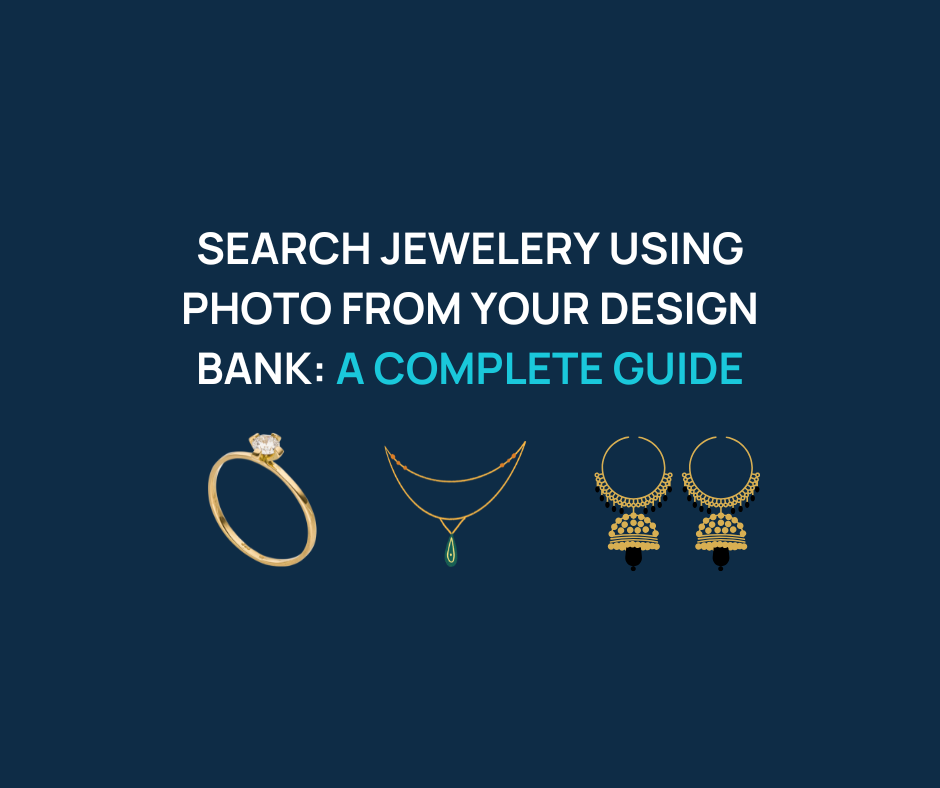August 18, 2025
| 8 mins read

Have you ever spotted a stunning piece of jewelry in a photo, on social media, or in real life and wondered where to find it? Traditional text-based searches often fall short when you're trying to describe intricate designs, unique settings, or specific gemstone arrangements. That's where jewelry image search technology revolutionizes how we discover and shop for jewelry.
Jewelry image search, also known as reverse image search for jewelry or visual jewelry discovery, allows you to upload a photo of any jewelry piece and instantly find similar or identical items across thousands of retailers and collections. This technology uses advanced computer vision and AI algorithms to analyze the visual characteristics of jewelry pieces, including:
Unlike traditional keyword searches where you struggle to describe a "vintage-inspired rose gold ring with small diamonds around a center stone," image search understands exactly what you're looking for through visual analysis.
Modern jewelry image recognition software employs sophisticated machine learning models trained on millions of jewelry images. Here's the step-by-step process:
Computer Vision Algorithms analyze geometric shapes, proportions, and spatial relationships within jewelry designs. Deep Learning Networks recognize complex patterns and style elements that traditional search methods miss. Color Analysis Systems identify metal types, gemstone colors, and finish qualities with remarkable accuracy.
Lighting is Everything: Natural daylight provides the most accurate color representation. Avoid harsh shadows or overly bright conditions that can distort gemstone colors and metal finishes.
Focus on the Piece: Remove or minimize background distractions. The jewelry should occupy at least 60% of the image frame for optimal recognition accuracy.
Multiple Angles: If possible, capture or upload multiple views of the same piece. Front-facing shots work best for rings and earrings, while necklaces benefit from flat-lay photography.
Resolution Matters: Higher resolution images (at least 1080px wide) provide more detail for the recognition algorithms to analyze.
Challenge: Blurry or Low-Quality Images
Solution: Use image enhancement tools or retake photos with better focus and lighting
Challenge: Multiple Jewelry Pieces in One Photo
Solution: Crop the image to focus on one piece at a time for more accurate results
Challenge: Reflective Surfaces Creating Glare
Solution: Adjust the angle or use diffused lighting to minimize reflections
Challenge: Similar Styles with Different Details
Solution: Use additional filters or search refinements to narrow results by specific characteristics
Once you have initial search results, jewelry photo matching services typically offer advanced filtering options:
Exact Matches: Identical pieces from the same designer or manufacturer Style Matches: Similar designs with comparable aesthetics but different details Inspiration Matches: Pieces that share design elements but may vary significantly in execution
Most jewelry visual search tools rank results by similarity percentage, helping you understand how closely each result matches your original image.
AI-Powered Recommendations are becoming more sophisticated, learning from user preferences and search patterns to suggest increasingly relevant pieces. Augmented Reality Integration combines image search with virtual try-on capabilities, though the image search component remains the foundation for discovery.
Real-Time Market Analysis through image search data helps predict jewelry trends and consumer preferences. Blockchain Integration may soon enable image search across verified authentic jewelry databases.
The jewelry image search market is experiencing rapid growth as consumers increasingly prefer visual discovery methods over traditional text-based searches. Industry reports indicate that visual search queries in the jewelry sector have increased by over 300% in the past two years.
Mobile-First Shopping drives much of this growth, as consumers frequently encounter jewelry inspiration through social media and want immediate search capabilities. Generation Z and Millennial shoppers particularly favor image-based discovery methods, making visual search essential for jewelry retailers targeting younger demographics.
When selecting a jewelry photo search engine, consider these essential features:
Search Accuracy: Look for platforms with high precision in matching jewelry styles and characteristics Database Size: Larger image databases provide more comprehensive results Update Frequency: Regular database updates ensure access to latest jewelry collections Integration Options: API availability for business users and developers Mobile Optimization: Seamless mobile experience for on-the-go searches Advanced Filtering: Comprehensive options for refining search results
Speed and Performance: Image processing and result delivery times User Interface: Intuitive design for both novice and expert users Customer Support: Technical assistance and user guidance availability Pricing Structure: Cost-effectiveness for different user types and volumes Data Privacy: Secure handling of uploaded images and search data
Create a systematic approach to jewelry style finder by picture searches:
Inspiration Boards: Collect images of jewelry styles you admire from various sources Trend Tracking: Regularly search trending jewelry photos to stay current with styles Wishlist Management: Organize found pieces by occasion, price range, or style category Comparison Shopping: Use image search to find the best prices for identical pieces
Instagram and Pinterest serve as excellent sources for jewelry inspiration photos. Screenshot or save images of pieces you admire, then use image search to find purchasing options. Many jewelry brands now optimize their social media content specifically for image search discovery.
TikTok Jewelry Trends often feature unique or hard-to-find pieces. Image search technology helps bridge the gap between social media inspiration and actual purchasing opportunities.
Jewelry image search technology has fundamentally transformed how we discover, compare, and purchase jewelry. Whether you're searching for a specific piece you've admired, looking for alternatives to expensive designer jewelry, or simply exploring new styles, image search provides an intuitive and powerful solution.
The ability to find similar jewelry by photo eliminates the frustration of inadequate text descriptions and connects you directly with pieces that match your visual preferences. As this technology continues to evolve, we can expect even more sophisticated features like style mixing, trend prediction, and personalized recommendations based on visual preferences.
Ready to revolutionize your jewelry shopping experience? Try mirrAR's advanced image search technology today and discover how visual search can transform the way you find and explore jewelry.
Just fill out the form and we’ll get back to you within 24 hours!
